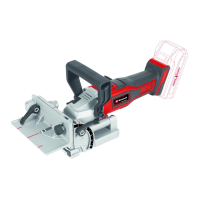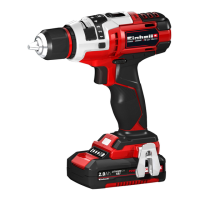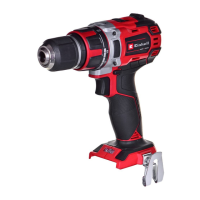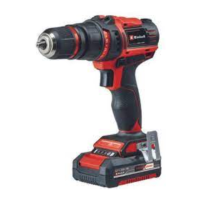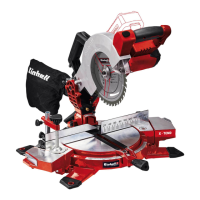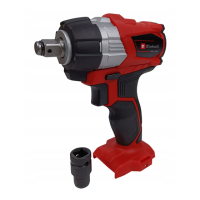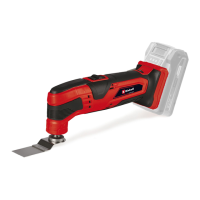EN
- 14 -
5.6 Line guide (Fig. 7-9/Item 6)
Using the line guide (6) you can carry out exact
cuts following cutting lines marked on the
workpiece. Fit the line guide by mounting the line
guide (6) on the top of the soleplate (7) and letting
it lock in place at the bottom, as shown in Fig. 7.
Use the mark in the middle, see arrow, for the 0°
angle setting (Fig. 8) and the mark on the left or
right, see arrow, for the 45° angle setting (Fig. 9).
See point 5.4 for information about the angle
setting.
Important! Carry out a trial cuts in a piece of
waste wood.
5.7 Splinter guard (Fig. 10/Item 17)
The splinter guard ensures that the material
you want to cut does not splinter or crack
during sawing. Insert it into the soleplate from
underneath as shown in Fig. 10.
Important! The splinter guard can be used only
for 0° cuts and must be removed for miter cuts up
to 47°!
6. Operation
6.1 On/Off switch (Fig. 12/Item 3)
Switching on:
Press the locking button (2) and the On/Off switch
(3).
Infi nitely variable stroke speed control is possible
with the On/Off switch (3). The further you push
the switch, the higher the stroke speed.
Switching off :
Release the locking button (2) and the On/Off
switch (3).
6.2 Setting the pendulum action (Fig. 13/Item
8)
•
The strength of the pendulum action of the
saw blade (12) can be adjusted using the
selector switch for pendulum action (8).
•
You can adjust the cutting speed, cutting
performance and appearance of the cut to the
workpiece you want to saw.
Set the selector switch for pendulum action (8) to
one of the following positions:
Position A = No pendulum action
Material: Rubber, ceramic, aluminium, steel
Please note: For fi ne clean cuts, thin materials
(e.g. sheet steel) and hard materials.
Position B = Small pendulum action
Material: Plastic, wood, aluminium
Please note: For hard materials
Position C = Medium pendulum action
Material: Wood
Position D = Large pendulum action
Material: Wood
Please note: For soft materials and sawing along
the grain
The best combination of speed and pendulum
action depends on the material you want to saw.
We recommend you to make a trial cut on a waste
piece in order to check the ideal settings.
6.3 Making cuts
Caution!
•
Make sure that the On/Off switch (3) is not
depressed. Only then should you connect the
battery pack to the equipment.
•
Do not switch on the jigsaw until you have
fitted a saw blade.
•
Use only saw blades that are in perfect
condition. Replace blunt, bent or cracked saw
blades immediately.
•
Place the saw foot flat on the workpiece you
want to saw. Switch on the jigsaw.
•
Allow the saw blade to accelerate until it
reaches full speed. Then slowly move the saw
blade along the cutting line. Exert only gentle
pressure on the saw blade as you do so.
•
When cutting metal, apply a suitable coolant
along the line you want to cut.
6.4 Sawing out sections (Fig. 14)
Drill a 0.4 in. hole in the section you want to saw
out. Insert the saw blade into this hole and start to
saw out the required section.
6.5 Making parallel cuts (Figure 15)
•
Mount the parallel stop and adjust as required
(see section 5.3).
•
Observe the instructions in section 6.3.
•
Cut as shown in Fig. 16.
Anl_TE_JS_18_Li_SPK7_USA.indb 14Anl_TE_JS_18_Li_SPK7_USA.indb 14 12.07.2019 12:22:1712.07.2019 12:22:17
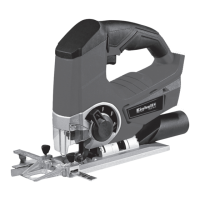
